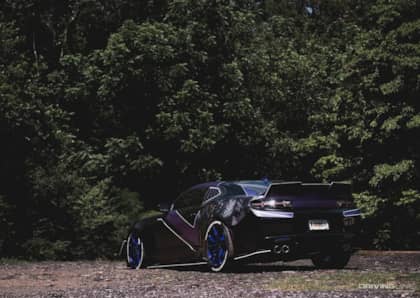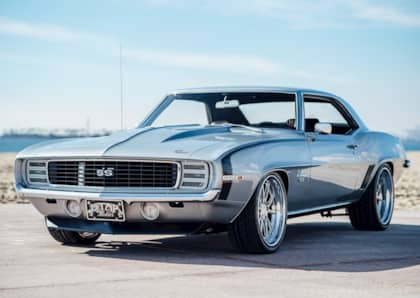5 Coolest Prototype Chevrolet Camaro Muscle Cars That Were Never Built (And What We Got Instead)
The Chevrolet Camaro is a muscle car icon, but its destiny wasn't always set in stone. Over the course of its production from the late 1960s until today, General Motors experimented with a number of prototypes and concept cars that could have dramatically changed the history of the Camaro and set it on a very different path.

These are the Camaros that never were, fantasies that were killed by bean counters, squashed by technological limitations, or simply considered too far out to fit comfortable into showrooms. Some of them promised better practicality while others sought to introduce advanced features that weren't quite ready for prime time. In the end, none of them survived as anything more than museum pieces, clay models, or in some cases, photos in a drawer.
Here are the 5 coolest Chevrolet Camaro prototype muscle cars that were never built.
5. Chevrolet XP-873
What Was It?
In 1967, General Motors was starting to feel the heat from cheap imports offering Americans a decent small car experience paired with frugal fuel consumption. Although it was already offering several down-sized sedans and coupes (like the Nova and the Corvair), it decided to explore a miniaturized coupe based on the Chevrolet Camaro's platform.

The Camaro had just gone on sale that year, and Chevy set to work shrinking down its proportions until they were roughly the same size as the Volkswagen Beetle. The program was dubbed XP-873, and it was intended to carry four passengers and be inexpensive to produce to give it a fighting chance, price-wise, against European and Japanese rivals.
Why Was It Never Built?
XP-873 was designed during the same period that GM was planning to expand the Corvair family of vehicles and potentially create a sub-division within Chevrolet for it.

As a result, some friction about XP-873's styling arose between designers Geza Loczi and Roy Lonberger and styling chief Bill Mitchell, who wanted the econo-coupe to head in a more Corvair-oriented direction. Eventually, both the mini-Camaro and the planned Corvair renaissance were canceled.
What Did We Get Instead?
The most obvious derivative of the XP-973, at least from a design perspective, is the Chevrolet Vega, a compact car that shared a significant resemblance to the second-generation Camaro when it appeared on the scene just a couple of years later.

The Vega resulted from an entirely different development program, but it did attempt to stay the import tide as a sporty-looking compact with its skin-deep Camaro ties.
4. 1968 Chevrolet Camaro Caribe
What Was It?
The first-generation Chevrolet Camaro sprouted a number of unusual show cars that toured the circuit drumming up excitement for the brand, but none with as much production potential as the Caribe. The Camaro Caribe was quite simply ute version of the coupe, or in popular terms a smaller El Camino. Also sporting a unique targa-like convertible design (with passengers protected by a roll bar), the Caribe wasn't just a modified Camaro but a completely custom vehicle built on the muscle machine's platform and made to resemble the popular coupe as much as possible.

Why Was It Never Built?
The El Camino was likely not popular enough to start spreading its influence outside of the mid-size segment where it had originally taken root. Ford had tried a smaller version of its Ranchero ute based on the Falcon, but it was nowhere near as successful as the next Falcon-platform variant — the Mustang — would be. Given that the Camaro was duking it out with the pony car set and not the pickup crowd, a utility-focused body style didn't make much sense.
What Did We Get Instead?
The Caribe lasted until 1969, after which it was retired as Chevrolet geared up for the next-generation version of the Camaro. What came next was a completely different take on practicality on the Camaro platform: the Kammback.
3. 1970 Chevrolet Camaro Kammback
What Was It?
With the Caribe out of the picture, cargo-toting Camaro fans within GM decided that maybe a wagon version was where it was at. The Kammback was tapped for prototyping after a more aggressively-styled Bob Ackerman sketch piqued the interest of design honcho Hank Haga, and a fiberglass model first appeared in 1970.

Named after a pioneer in aerodynamics, the slight taper of the Kammback helps improve fuel efficiency as compared to a traditional flat-and-square wagon design.
Why Was It Never Built?
In a word: budget. In order for the Camaro Kammback to be as useful as possible the rear hatch had to fully open, which meant moving the prototype's tail lamps to the rear quarter panels. This required Chevrolet to create an entirely new quarter to accommodate them as well as fully integrate the style line running down the entire side of the vehicle.

In the end, there wasn't enough money to produce such an elaborate riff on the Camaro silhouette.
What Did We Get Instead?
The Kammback concept stayed alive and well at Chevrolet, revived shortly afterwards in production form for the Vega Kammback.

Pontiac would also produce a prototype Firebird Kammback (the K-Back or Type K) in 1977 (re-bodied as a Trans Am for a role in The Rockford Files two years later), and then again in 1985 in Trans Am form (serving as IMSA pace cars).

For a time, it was even possible to order a Kammback conversion kit from a company called Deco International that would give any 1977-1981 Firebird the Type K look.
2. Front-Wheel Drive Chevrolet Camaro
What Was It?
Ford wasn't the only Detroit automaker lured by the perceived cost and efficiency benefits of converting its muscle car icon to front-wheel drive.

The Mustang narrowly avoided having its name plastered on the coupe that eventually became the Probe, and a similar fate almost befell the third-generation Camaro and Trans Am, which saw a string of prototypes built to explore the potential for a front-wheel drive model.

Dubbed the GM-80 program, the mid-'80s coupe not only swapped out the traditional rear-wheel drive setup for a front-puller (to be augmented by available all-wheel drive), but it also dumped small block V8s in favor of four and six-cylinder power. It was to be motivated by a mix of Quad 4 four-cylinders and 3.4L V6s, with the latter pushing out nearly 300 horses.
Why Was It Never Built?
While that 3.4L power plant sounded sweet on paper, in reality the rest of the would-be Camaro replacement's drivetrain couldn't keep up, which forced engineers to detune the unit to a mere 200 ponies to prevent transmissions from grenading themselves. Then there were the costs associated with building the unique plastic bodies for the cars, which finally convinced top brass that it was time to pull the plug on a project that had already blown through its budget.

Production expenses would have required the GM-80 to feature a much higher price than the market would bear, and there was no clear path to recouping any of those funds in a market that wasn't exactly screaming for a high tech, high-dollar Camaro replacement.
What Did We Get Instead?
At the very least, GM saw some return on its investment in the form of the fourth-generation Camaro's shape, which was based in part on the design studies associated with the GM-80 cars.

The General never went all-in on a tech-laden, front-wheel drive coupe, relying instead on the evolution of the Quad 4 which would peak under the Oldsmobile badge in the early '90s.
1. 1989 Chevrolet Camaro IROC-Z Concept
What Was It?
Building on the shape of the front-wheel drive GM-80 Camaro body was the IROC-Z or California Camaro concept. Similar in esthetic to the Pontiac Banshee IV that would dazzle auto show attendees, the IROC-Z concept appeared in 1989, a full four years before the production fourth-gen Camaro hit dealerships.

Both the California Camaro and the Banshee IV were intended to usher in a new aero-focused era for GM's muscle cars. With gullwing doors, an aviation-inspired gauge layout, and for some reason an integrated vacuum cleaner that could be stowed in the center console, the Camaro also featured a 250hp V6 instead of a thundering V8.
Why Was It Never Built?
Chevrolet had no interest in building a gullwing Camaro, and that muscle car fans had even less desire to add a vacuum to the options list. Other attention-grabbing features like a driver's seat that could be custom-fit to the owner were also non-starters for a volume-seeking production vehicle.

As an attention-grabber, the IROC-Z concept was a huge success, but it had no business being near an assembly line.
What Did We Get Instead?
The fourth-generation Chevrolet Camaro is very clearly descended from a mix of GM-80 and IROC-Z lines.

The concept also had an impact on the C5 Corvette, giving the Advanced Design Concept Center in California (which had produced the prototype) a window into influencing the replacement for the C4 Corvette that was on sale at the time through 1992's Sting Ray III concept (aka the California Corvette).
More From Driving Line
- Curious about other special edition Camaros? Check out this round-up of the coolest, rarest version of Chevrolet's muscle car ever built.











